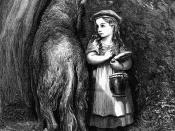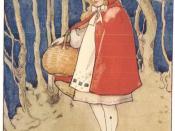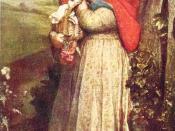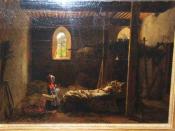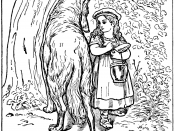Fairy tales are a convenient medium for the transmission of ideal standards of behavior, and are considered effective tools in the socialization process. However, effective is not synonymous with appropriate, and although the use of fairy tales seem harmless, the underlying themes can have undesirable effects on the population's psyche. Fairy tales are full of anxiety and tragedy that seems to plague young girls, which therefore creates a culture that is accustomed to the notion that women are victims; in other words, the damsel-in-distress syndrome. In his rendition of the classic fairy tale Little Red Riding Hood, Charles Perrault attempts to teach children, specifically young girls, about the dangers of succumbing to the temptations of sexual desires, and the unfortunate consequences that could befall them. Perrault's Little Red Riding Hood inadvertently supports the notion that women are "willing participants in their own defeat"æ[and that] women want to be raped"� (Zipes 232).
However, Angela Carter's version of Little Red Riding Hood"""The Company of Wolves"�""does not characterize the female protagonist as the victim of a sexual predator. Carter departs from the traditional fairy tale notion that women are "ÃÂinnocent' victims, and instead looks at women's sexual liberation; thus, she not only transforms little red Riding-Hood into a sexually active young woman who is able to recognize her internal animal characteristics and desires, but also opposes the traditional male fantasy of the willing rape victim.
Folklore and fairy tales often characterize the wolf as a representation of evil, an expression of sexuality, or a metaphor for a male predator, all of which are characteristics of the antagonist in both Little Red Riding Hood and "The Company of Wolves."� However, Carter and Perrault differ in their portrayal of the female protagonist. While the wolf is a symbol of experience, specifically carnal experience, its opponent is the lamb, which is a symbol of innocence and purity, and is often portrayed as the wolf's unfortunate prey; little red Riding-Hood can therefore be characterized as a lamb. Moreover, Perrault's version characterizes little red Riding-Hood as both an emblem of innocence and a young girl who has recently reached puberty, whereas Carter's leading lady is an independent young girl who is not only pubescent, but about to discover her sexuality. Little red Riding-Hood's recent admittance into the realms of womanhood is represented by the red color of her coat"""The red shawl that, today, has the ominous if brilliant look of blood on snow"�""and thus implies both the possible awakening of her sexual desire and the possibility that she could get pregnant (Carter 113). It is therefore necessary for Perrault to emphasize that young girls should be wary of sexual desires because they will be consumed by their own sexuality, which will lead to their destruction. In other words, "the girl is guilty because of her natural inclinations and disobedience"� and is therefore responsible for her own demise, which is being raped and eaten by the wolf (Zipes 232). In Perrault's version of Little Red Riding Hood, the Wolf, under the guise of her grandmother, commands the little red Riding-Hood to join him in bed. The little red Riding-Hood immediately follows his instructions, and gets into bed with him: "The little red Riding-Hood undressed her self, and went into bed"æ[where the] wicked Wolfe fell upon the little red Riding-Hood"� (6). Consequently, Perrault shows that both the grandmother's and little red Riding Hood's death result from her yielding to her carnal desires, and through his pessimistic illustration, he not only describes girls' ideal characteristics, but also unconsciously encourages society to excuse male sexual dominance and predatory behavior (6-8).
However, rather than being the "image of male desire"æ[and] an object without a will of her own,"� Angela Carter's heroine is a sexual young girl who is a threat to androcentric societies (Zipes 258). Instead of being eaten by the wolf, for little red Riding-Hood knows "she [is] nobody's meat,"� she boldly removes her clothes""specifically her red shawl, which Carter describes as, "the colour of poppies, the colour of sacrifices, [and] the colour of her menses"�""and fornicates with the wolf (Carter 117-8). By acknowledging her desires and becoming sexually active, little red Riding-Hood recognizes the carnal or natural passions of humans, whose sexual appetites parallel animals: "The [wolf] will never lie down with the lamb; he acknowledges no pact that is not reciprocal. The lamb must learn to run with the [wolves]"� (Carter 64). Carter's creation of a female protagonist who is both sexually active and personally enlightened enables her to shatter Perrault's archaic damsel-in-distress mentality.
Fairy tales may be magical journeys for imaginations, but they also deal with a constant struggle between one's good and bad qualities. The author(s) and/or creator(s) of fairy tales often attempt to provide people with personal assessments of ideal morals and values that will help people formulate solutions to moral predicaments, and assist in their emotional and psychological development. Perrault denies the need for emotional and psychological balance, and instead, endeavors to educate society on the consequences of sexual deviance. His depiction of Little Red Riding Hood, however, perpetuates the concept that "women want men to rape them,"� and as long as fingers are pointed at: Little Red Riding Hood as willing conspirator in her own downfall"æour minds and bodies will be prevented from grasping the fundamental issues of sexuality at stake in the story and in our lives (Zipes 242,259).
Conversely, Carter effectively shows that the eternal battle between good and evil, the innocent and the corrupt, are in fact complementary rather than opposing human characteristics; that is, the two forces are harmonious because they provide humans with equilibrium. Neither the Wolf nor little red Riding Hood is good or evil because instead of representing one extremity, they epitomize both. This is similar to Confucian's belief in yin and yang""yin being dark, cool, and female, while yang is bright, hot, and male""which asserts people will act appropriately when their lives are in balance. In other words, the achievement of self-realization can only be obtained after one accepts and understands both the dark and the bright sides in human nature. We all hear the wolf calling our names, a "carnivorous incarnate"� persuading us to succumb to temptations of pleasure, because the wolf and the evil it represents is personified in everything and everyone around us (Carter 116).
Works Cited Carter, Angela. The Bloody Chamber. New York: Penguin Group, 1979.
Perrault, Charles. Histories: or, Tales of Past Times. New York: Garland, 1977.
Zipes, Jack. Don't Bet on the Prince. New York: Methuen, 1986.
